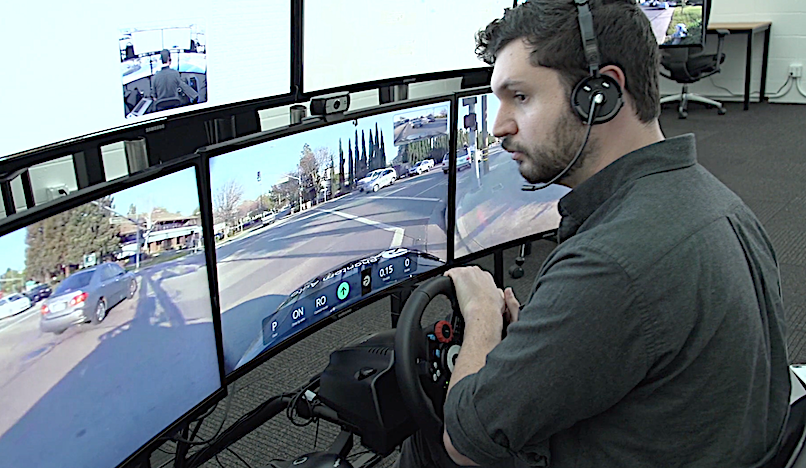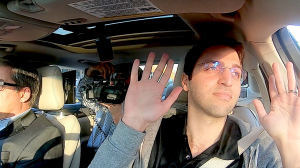 AI
AI
 AI
AI
 AI
AI
Talk with any company involved in autonomous cars, and it’s likely to insist that it wants to take the driver out of the car, full stop. One startup is taking a different approach. It wants to keep the human driver — just not in the car itself.
Phantom Auto has begun piloting technology for autonomous cars that allows a human driver, sitting in a quiet room up to thousands of miles away, to take control of the vehicle in critical situations where driverless systems draw a blank. Its technology is designed to get both skeptical regulators and wary passengers comfortable with the idea of letting a machine drive a car.
The current climate surrounding autonomous cars offers a good reason why an extra layer of safety might be just what the industry needs. A survey conducted by the American Automobile Association last year showed that 78 percent of U.S. drivers feel unsafe about the prospect of riding in a driverless car. And at the Consumer Electronics Show in Las Vegas in early January, Secretary of Transportation Elaine Chao warned the industry that the government was not even close to allowing unfettered autonomous driving.
“The reason why we’re still not there yet is because there are many corner cases, edge cases,” said Phantom Auto co-founder and Chief Executive Shai Magzimof, a serial entrepreneur who has sold two companies, one of them to Apple Inc. “I wanted to make [driverless cars] happen faster and sooner, because it’s a life-saving technology. This is going to change the world.”
Jeff Frick, host of SiliconANGLE Media’s mobile livestreaming studio theCUBE, met with Magzimof during a recent visit to Phantom Auto’s Mountain View, California headquarters. He also spoke with Elliot Katz, the company’s co-founder and head of business, legal and policy; Jordan Sanders, director of business and operations; and software engineer Ben Shukman (pictured at Phantom’s remote-driving management console, above). They discussed how the company plans to provide safety and trust so that driverless cars will become widely accepted, how the company designed technology to overcome latency issues, and the regulatory future for autonomous vehicles.
Here’s a video summary of theCUBE’s Innovation Day at Phantom, which also provided a test drive in its outfitted Lincoln MKZ:
The current problem confronting the autonomous car industry is that no manufacturer can guarantee 100 percent safety 100 percent of the time. That might seem like a tough standard, given that 94 percent of car crashes today are caused by human driver error. But it’s the edge case, such as messy construction zones with piles of mud in the road and workers directing traffic using hand signals, where autonomous technology may not be completely reliable. This is the gap Phantom Auto believes it can fill.
“We’re all about safety and giving passengers this psychological trust,” Magzimof said.
Here’s the complete video interview with Magzimof:
Phantom’s solution equips an autonomous car with a combination of software and hardware to allow a human operator to take over control of the vehicle when necessary. The fundamental architecture is drive-by-wire, electronic signals already installed in many cars that enable key features.
“We can create an artificial electronic signal and inject it into a place in the vehicle where it processes that information and artificially moves the steering wheel or the brakes or the gas,” Shukman explained.
Here’s the complete video interview with Shukman:
Using cameras mounted in the vehicle, an operator in Phantom Auto’s Silicon Valley headquarters can visually see the road ahead and maneuver the car using a steering wheel attached to a computer console. A remote operator can also verbally communicate with passengers inside the car. The tricky problem of being able to gauge how much pressure to apply for braking remotely is solved through the use of sensors and accelerometers.
For now, at least, the company uses largely off-the-shelf components, such as high-end Logitech International SA’s game controllers and control pedals. Indeed, each control module looks like an advanced video game or simulator in which the remote driver sits, watching five screens that include front and side views from the car’s perspective as well as data on latency and other functions.

Phantom Auto CEO Shai Magzimof
The biggest technological hurdles for Phantom Auto involved latency and reliability. Remote control of a moving car depends on a reliable, strong cell signal and real-time response. The company’s solution was to use multiple wireless carriers at the same time, combining signals from Verizon and AT&T with T-Mobile and Sprint. A machine learning algorithm directs connectivity across networks in case one signal suddenly gets throttled or degrades.
That latency solution, Magzimof said, is the company’s “secret sauce.” It uses multiple cell connections in each car to provide more reliable connections, automatically choosing the fastest connection in the “bonded” setup. Some data, such as a signal from the brake as well as the video stream, get priority for lower latency.
The system proved to work far better in real time than the company expected. Magzimof said that when the company tried to fix a network glitch while operating from a Las Vegas hotel during demos at the Consumer Electronics, it found that the system worked perfectly from Mountain View, 400 miles away. “It changed the business model of the company,” he said, partly because the fact that it works over such great distances means drivers could be located in lower-cost areas.
Security can also be a concern. Phantom Auto has addressed that by working with a variety of cybersecurity firms to ensure system protection across multiple vectors. “As we get closer to deployment of [fully autonomous] robo-taxis, there’s a need for remote assistance, and we think we have the best solution on the market,” Sanders said.
Here’s the complete video interview with Sanders:
Because it has the largest number of registered cars in the nation, California offers a key benchmark for determining the regulatory future of autonomous vehicles. The state issued draft regulations governing the testing and deployment of driverless cars last year that allowed for the removal of a human driver during testing on the roads but required a communications and control link using remote operators.
There are also bills in Congress that could follow California’s lead and mandate regulations for driverless cars. “We might have the rare scenario where the regulation outpaces the technology, which is a good problem to have,” Katz said. “We expect that one [bill] will go the distance this year.”
Behind Phantom Auto’s confidence in its business model is a belief that ultimately regulators and passengers will accept a driverless solution because it’s a safer alternative to the situation today. Data shows that 1.2 million people worldwide are dying every year in traffic accidents, which is the equivalent of eight 747 airplanes crashing every single day for 12 straight months, according to Katz.
“If we had that happen even for just two weeks in the U.S., aviation wouldn’t exist as we know it,” Katz said. “These are lifesaving vehicles, and we want these out on the road as quickly as possible.”
Here’s the complete video interview with Katz:
Although it has outfitted a Lincoln MKZ luxury sedan with standard self-driving components, adding its own technology on top of that, Phantom Auto doesn’t plan to offer its own cars. Instead, said Magzimof, it will work with ride-hailing firms to add its software and a small amount of hardware. Magzimof said some partnerships could be announced soon. He also has been talking with outside companies to operate control centers with the drivers in them.
In a sense, these potential partners and makers of autonomous vehicles are aiming to make Phantom Auto unnecessary, but Magzimof thinks some kind of human assistance will be necessary for many years to come to handle situations where cars might encounter problems.
It’s far from certain whether this kind of human assistance is scalable to potentially millions of vehicles on the road. Magzimof said currently one remote driver at Phantom can handle five vehicles at a time, perhaps moving up to 10 in a year and eventually to a thousand as AI gets progressively better at eliminating more corner cases.
With reporting from Robert Hof
Support our open free content by sharing and engaging with our content and community.
Where Technology Leaders Connect, Share Intelligence & Create Opportunities
SiliconANGLE Media is a recognized leader in digital media innovation serving innovative audiences and brands, bringing together cutting-edge technology, influential content, strategic insights and real-time audience engagement. As the parent company of SiliconANGLE, theCUBE Network, theCUBE Research, CUBE365, theCUBE AI and theCUBE SuperStudios — such as those established in Silicon Valley and the New York Stock Exchange (NYSE) — SiliconANGLE Media operates at the intersection of media, technology, and AI. .
Founded by tech visionaries John Furrier and Dave Vellante, SiliconANGLE Media has built a powerful ecosystem of industry-leading digital media brands, with a reach of 15+ million elite tech professionals. The company’s new, proprietary theCUBE AI Video cloud is breaking ground in audience interaction, leveraging theCUBEai.com neural network to help technology companies make data-driven decisions and stay at the forefront of industry conversations.